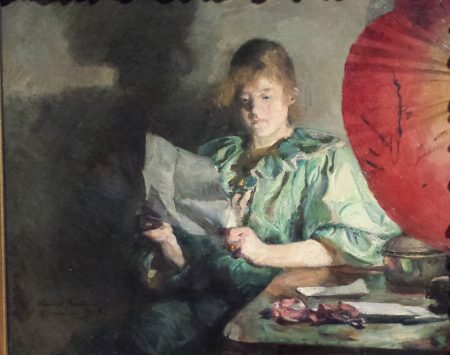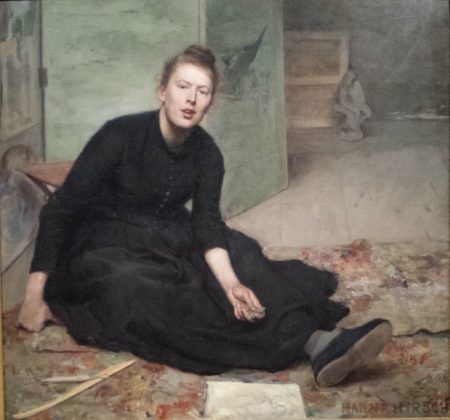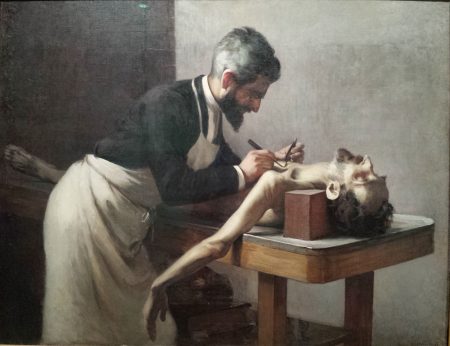The Speed Museum exhibition” Women Artists in the Age of Impressionism” brings together over 80 paintings by 37 different female artists.
Their achievement becomes more remarkable as it was accomplished in the historical context of denial of academic access in a world dominated by men.
European study and salon success was the prescribed path for all to a successful professional career in the fine arts. Additionally it was prescribed that women could not take on marital duties to husband and family if their intention was to become a first class professional. A few additional points can be briefly stated here.
Women could not study at the Ecole des Beaux-Arts, the famed French academy that enrolled the best male students from all over the world, until 1897. Second rate ateliers tolerated sex-separated classes with patronizing instructors, reduced and weakened instruction and critiques for females at double the rates charged for male students.
Moral and social stigmas denied women access to nude model drawing and painting. Elizabeth Jane Gardner Bouguereau, wife of the painter and teacher William-Adolphe Bouguereau, disguised herself as a man to gain access to life drawing classes with unclothed models.
Successful salon exposure, while difficult to achieve, proved the seriousness of female talent and was one place where their work could compete and compare with male output of the day.
Women students networked among female friends and connections, an integral part of informal support, while cultivating the patronage of their instructors who could have influence at the salons. The writings of Mary Cassatt and Cecilia Beaux, recognized women artists today, reflect the strategic navigations that women faced to overcome these and additional barriers to opportunity and success.
This extensive array of large, competent canvases by women artists who came from around the world to establish their career in Paris, the center of the art world in the late 19th and early 20th century, is testimony to their high professional aspirations not only by the size of the works but also the difficulty, variety and range of subject matter. The exhibition opens with several compelling portraits of women by women.
I admired the portrait of Venny Soldan-Brofeld by her Swedish friend Hanna Pauli. The young woman looks up from the floor of the room with sketches and materials in hand, her dark dress accenting the greenish grey studio interior where equipment and miscellaneous elements are peripherally scattered.
Rosa BonHeur, self-described ‘animalier’, is portrayed at her easel considering a sketch. Her youthfully styled, silvery hair is a halo highlighting her confident gaze at the height of her powers. BonHeur’s portrait, which exudes natural light and gesture, is captured by fellow artist Anna Elizabeth Klumpke.
The self-portrait by Elizabeth Nourse from the Cincinnati Art Museum collection reveals Nourse’s skills as well as her self- effacing candor. The three quarter length portrait views the artist from the side, apron frocked, her straight forward gaze absorbed in a moment of self- appraisal. Other studio accoutrements are shown but do not detract from the depicted action: the internal process of contemplation and artistic determination occurring within.
” Woman’s place is more naturally before a mirror than the easel.”
1800’s art critic
There are several works idealizing the fashion styles of the day, women in beautiful gowns, holding fashionable fans and perhaps lolling before the mirror, which can be seen as a symbol of the decorative domestic role assigned to women.
Several works portray dutiful women in the company of a male companion or presiding at tea service with multi-generational family members. Mary Cassatt paints children with charm and innocence, at play on the beach or being guided by a caregiver’s hand in “Child with Nurse”.
Cecilia Beaux’s beautiful portrait ” Sita and Sarita” is a pleasure to experience visually. Its assurance and contemporary handling is a testament to Beaux’s artistic command and personal vision which continues to appeal.
In contrast, several works portray women in solitude, where reflection, reading and writing are evidence of women cultivating the intellectual pursuits of the mind. Norwegian artist, Harriet Backer, develops the reading theme in “Evening, Interior” using a dramatic lighting effect of Asian influence.
Also to be seen in this exhibit are several examples of extraordinary subject matter, extraordinary in the very fact that they stray from the domestic scenes of children and family that women usually portrayed.
One is an example by Rosa BonHeur, depicting a straining team of oxen plowing an open field under a blue sky. This large painting is striking in its outdoor brilliance and the artist’s formidable observation and knowledge of the animals portrayed in their traces. One beautifully painted white bull that virtually lives and breathes on the surface, pins the viewer with full direct eye contact, a testament to BonHeur’s ability to animate her works with life.
“Autopsy” (Professor Poirier, Paris) is a portrait of an autopsy procedure by Annie Stebler-Hopf. Born in Switzerland, Hopf trained in Berlin and traveled to Paris in 1882 where she studied at the Academie Julian. This work, so starkly composed in extreme value structure, depicts the professor from the École de Medecine de Paris intently proceeding with his scalpel on the male cadaver resting on a wooden block and table. As a work reporting on the scientific and medical directions of the day, it immediately brings to mind comparison with Thomas Eakins’ monumental work, “The Gross Clinic” of 1875. Hopf’s “Autopsy” explores the theme of medical investigation in a smaller format that succeeds by inventively composing with extreme values contrasting the characters and the background dramatically. In that sense, one can see the continuing influence of Thomas Eakins’ multiple character painting, considered by many to be one of the best American paintings ever made.
This exhibition of a conclave of international female artists is indeed a ground breaking testament to the talent of our predecessors who persisted against social and cultural barriers and would not be denied. Evident is the fact that their accomplishments in the 1870’s and 1880’s continues to shape the gender discussion in our times. As an artist, I am inspired by their courage and have found a calling to redefine personal self-expression.
“At the studio, all are equal, we have neither name, nor family…
we are ourselves… and before us is art and nothing else.
We feel so contented, so free, so proud!”
Friday, October 5, 1877, from the journal of Marie Bashkirtseff
–Marlene Steele


